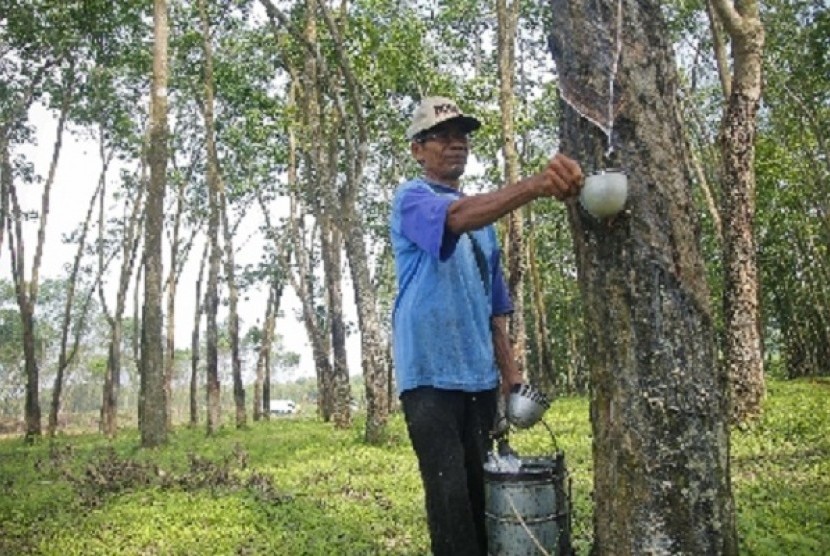REPUBLIKA.CO.ID, MEDAN -- Long time in the past rubber farmers in North Sumatra were not worried too much about how to feed their family.
A kilogram of latex was worth two kilograms of rice, the staple food, was the reminiscence of K. Siregar (50), a small rubber farmer in Labuhanbatu, North Sumatra.
"It was in the past, but now it is too much to expect," Sireghar said expressing his disappointment to no one in particular about the shrinking price of rubber.
In the past several years a kilogram of latex was not even worth a kilogram of rice, Siregar said here on Friday.
"Now the price of latex is only Rp6,000 per kilogram as against a Rp7,000 for a kilogram of rice, " he said.
No wonder many rubber farmers have converted their rubber plantations into oil palm plantations, he added.
Some who had no money to finance the conversion just abandoned their farmlands and chose to become daily paid workers in their villages or in Medan.
K. Siregar is one of those leaving his rubber plantation untended and works as a city bus driver in Medan.
Fortunately he had the driving license that he could take that job when working a whole day at his rubber plantation was not worth the money he spent for food.
"Life must go on, and you have your family to feed. That is always what I told myself," he said.
Siregar did not think about changing his crop as he had no money to buy seedling and fertilizer to grow oil palm trees. In addition he was not sure he could succeed as he had lived all the time only as a rubber farmer.
"Where could I have money from? I did not seek bank loan as I am not sure I could repay it later," he said.
Gapkindo suggests buffer stock
Secretary of the North Sumatra branch of the Indonesian Association of Rubber Companies (Gapkindo) Edy Irwansyah said many small rubber farmers had abandoned their farmlands and chose to become daily paid laborers.
"It has been a normal practice for them when the price of that commodity fell," Edy said.
It is in the interest of Gapkindo to see the rubber price rising to keep the farmers from abandoning their farmlands and risking the crop being damaged, he said.
However, it is not as easy as in the case of other commodities to raise the price to a reasonable level, he said, adding, "there are many factors involved."
Rubber price follows the trend in the oil market, besides being dependent on demand from consuming countries, exchange rate, supply and speculation in international market, he said.
He said the rubber price shrinking to less than US$3 per kilogram was a result of the global crisis, US dollar appreciation and false report by speculators that the market is flooded by big surplus.
He said the government and Gapkindo, together and separately, had sought to cooperate with other producing countries to improve the condition such as through export retention or a cut in production.
A 10 percent cut in production by world's largest producers grouped in the International Tripartite Rubber Council (ITRC) -- Thailand , Indonesia and Malaysia -- had been proposed and is being considered.
ITRC once adopted such policy in January-June , 2009 and October, 2011 - March , 2012, but still failed to significantly raise the price to a reasonable level of more than US$3 per kilogram.
On March, 27, the selling price of natural rubber, SIR20, at the Singaporean market was set at US$1.868 per kilogram for April's delivery.
"Perhaps what the government should do to help the farmers is by forming a buffer stock buying rubber from farmers when the price falls as Thailand has done.
"In the long run it is not good if more rubber farmers changed their crop resulting in Indonesia becoming a net importer of rubber," he said.
Exports up amid falling price
Despite the price fall , rubber exports from North Sumatra, one of the country's largest rubber producers, still continued to increase.
Natural rubber exports from the province grew 1.2 percent to 86,643 tons in the first two months of 2014 from 85,594 tons in the same period last year.
The increase in exports, though encouraging, did not indicate a market recovery this year, Edy said, adding the increase was attributable more to fulfilling contract carried over from last year.
Rubber exports from North Sumatra by Gapkindo members rose 3.64 percent to 509,126 tons in 2013.
Head of the North Sumatra office of the Central Bureau of Statistics Wien Kusdiatmono, said rubber is the second largest export earner after crude palm oil for the province. (Evalisa Siregar/Alberth Saragih)


